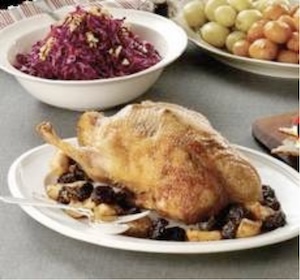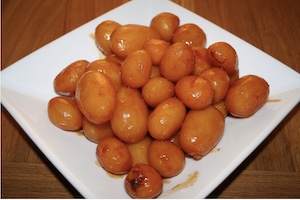In Denmark, lots of families eat roast duck with gravy and a side of caramelised potatoes and preserved red cabbage. The cabbage comes out of a glass (unless you're ambitious and make it yourself), but the rest is prepared on the night. I thought I'd write down how we do this, mainly as an excuse for learning how to do so using HTML to format things.
Roast duck

The duck is prepared and stuffed with apples and prunes before hitting the oven until it's perfectly cooked with a crispy skin for full Christmas happiness!
Preparation
Make sure the duck is nice and clean - on the outside as well as on the inside. If necessary, wash it inside with water and use your fingers to clean it.Some times the duck won't be tinkered properly, so some remains of the feathers are still stuck in the skin. Often, these are easy to remove with a knife or something similar - but if there are many, it may be useful to scold the duck. To do that, you slowly pour some boiling water over it, which should make it a lot easier to get those little things out.
Some people cut the tips of the wings off as they don't really contain much meat, and easily get burnt during roasting. They can be used for the sauce if you want.
Stuffing
When the duck is all nice, clean and prepared, it's violated by stuffing it with apples and prunes. The results are best if you use sour apples - for example cooking apples (they're often cheap too). I normally try to make sure the stuffing is mixed nicely inside, as the prunes and apples influence the taste of each other that way.
When it's as stuffed as possible, close it up with some meat pins or similar. If you don't have any pins, you can try to put a piece of foil to prevent the steam to escape from the inside.
Roasting
To show how good I am at making lists, check this out:
- Heat the oven to 225 degrees.
- Salt the duck by smearing the salt into the skin - it needs to stick to the duck reasonably well. If it won't, some oil can be poured on it to make it nice and sticky.
- Put the duck on it's back (the ugly side up) and put it in the oven for 20 minutes on the high heat.
- Take the duck out, turn it around on its belly and put it back in. (If it was hard to get the salt to stick earlier, pour a little salt over it now, but don't smear as you'll burn your hands).
- Turn the oven down to 160 degrees, and pour some water (not too much) in the roasting tin to help create some steam in the oven.
- Leave the duck in there until it's done. A good estimate is approximately 35 minutes pr kg of duck (without stuffing). So a 3kg duck would get 1h45mins for example.
- Make sure the roasting tin never runs out of water (but try not to open the oven too often, as the temperature decreases every time and the steam escapes).
- When the duck looks done, try to stab it with a knife. The juices coming out of it should be clear, and not bloody. The meat can be pink, but not the juices 😄
- Take the stuffing out of the duck and set aside.
- Carve the duck into nice pieces, and serve with the stuffing next to it.
Gravy

The traditional way to make the sauce is to chop the giblets from the duck in smaller pieces, and boil them with the wingtips in water. The water should only just cover the stuff, as it gets too thin otherwise. Boil it for an hour or so at low heat, so the water gets the taste.
Take some of the water from the roasting tin, and pour it in a glass. After a little while, it's easy to see the fat and avoid most of it when you pour it in a saucepan. You can take a bit of water from some vegetable boiling as well if you have any.
Pour everything through a sieve into the saucepan. Add salt and pepper to taste. Add a little sugar or red berry juice to add a bit of Christmas flavour.
Thicken the sauce with flour or cornflour, and check the taste again (it may need more salt or pepper). If the sauce isnʼt dark enough, add some browning for the looks.
Caramelised potatoes

Boil and peel the potatoes. Leave them to cool down while continuing the recipe.
Melt sugar in a pan (at low heat - be careful not to burn it).
When the sugar is completely melted, add the butter Do not stir the sugar during this process!
When sugar and butter has melted into a golden brown syrup, add the potatoes. They should be moist, but not wet (as the sugar wonʼt stick in that case).
Cook until the caramel has stuck nicely to the potatoes like a thick brown sauce.